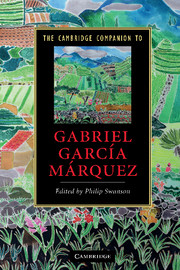Book contents
- Frontmatter
- Introduction
- 1 Gabriel García Márquez: life and times
- 2 The critical reception of García Márquez
- 3 Before One Hundred Years of Solitude: the early novels
- 4 One Hundred Years of Solitude
- 5 An eco-critical reading of One Hundred Years of Solitude
- 6 The Autumn of the Patriarch
- 7 The General in His Labyrinth
- 8 García Márquez’s novels of love
- 9 García Márquez’s short stories
- 10 García Márquez’s non-fiction works
- 11 García Márquez and film
- 12 García Márquez, magical realism and world literature
- Further reading
- Index
5 - An eco-critical reading of One Hundred Years of Solitude
Published online by Cambridge University Press: 28 September 2010
- Frontmatter
- Introduction
- 1 Gabriel García Márquez: life and times
- 2 The critical reception of García Márquez
- 3 Before One Hundred Years of Solitude: the early novels
- 4 One Hundred Years of Solitude
- 5 An eco-critical reading of One Hundred Years of Solitude
- 6 The Autumn of the Patriarch
- 7 The General in His Labyrinth
- 8 García Márquez’s novels of love
- 9 García Márquez’s short stories
- 10 García Márquez’s non-fiction works
- 11 García Márquez and film
- 12 García Márquez, magical realism and world literature
- Further reading
- Index
Summary
The vast majority of critical readings of One Hundred Years of Solitude (Cien años de soledad [1967]) appeared in the 1970s and 1980s, well before the recent rise of eco-criticism. The pioneer theorist of eco-critical readings, Lawrence Buell, published his seminal book on this subject, The Environmental Imagination, in the early 1990s, and since then a growing number of scholars and readers have been increasingly aware of the multiple roles and representations of nature in literature. Inevitably, many discussions of nature in literature lead to parallel considerations of elements that are not considered part of the natural world: culture and technology. In this study, I will begin with a discussion of background canonical literary texts for an understanding of nature and technology in One Hundred Years of Solitude, and then move to an eco-critical reading of García Márquez's work, with emphasis on One Hundred Years of Solitude. What is eco-criticism? I would bring to the discussion a 1999 definition constructed by the editors of a special issue on ecocriticsm of New Literary History that emphasises focus on the non-human. In this analysis, I will attempt to show how García Márquez constructs an elaborate and complex web of nature of multiple sources, but many of which, in fact, are human rather than non-human parts of nature. Of the human sources, two of the most noteworthy with respect to the representation of nature are, first, other literary texts and, second, oral tradition. I will explore each in this study.
- Type
- Chapter
- Information
- The Cambridge Companion to Gabriel García Márquez , pp. 64 - 77Publisher: Cambridge University PressPrint publication year: 2010
- 3
- Cited by



